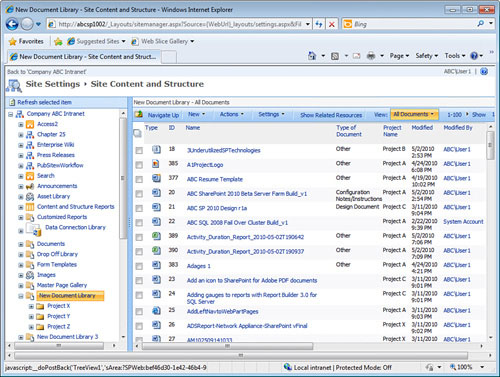On
the Site Settings page in the Site Administration section are a number
of links to additional tools that the site collection administrator
should be familiar with. The links that show will vary based on the
version of SharePoint 2010 in use and on the features enabled for the
site and site collection.
Of particular interest are the
Regional Settings tools, which are useful for multinational
organizations and customizing information such as the time zone and
setting the workdays and standard work hours for the organization. The
RSS, Search and Offline Availability, and Workflow Settings links enable
the administrator to determine whether specific features are going to
be made available in the site collection.
A summary of these tools is as follows:
Regional Settings—
Allow the administrator to set locale, sort order, time zone, calendar
type, alternate calendar, days in the workweek, first day of the week,
start time, first week of the year, end time, and time format. Site Libraries and Lists— Shows all lists and libraries in the current site. Allows creation of new lists and libraries, pages, and sites. User Alerts—
Shows any existing alerts on the site and allows their deletion. This
can be useful to simply see whether users are taking advantage of
alerts, but also to delete alerts after a user changes roles or
positions, or leaves the company. RSS—
Defines whether RSS feeds are allowed in this site collection, and
whether they are allowed in the site itself, and if copyright
information is attached to RSS feeds, who the managing editor and
webmaster are, and defines the time to live in minutes. Search and Offline Availability—
Allows the administrator to determine whether the site will appear in
search results, the site’s aspx page indexing behavior, and whether
items can be downloaded to offline clients. Sites and Workspaces—
Shows sites, document workspaces, and meeting workspaces that exist
below the current site.
Workflows— Shows which workflows are active and inactive and the number of associations each has and the number in progress. Workflow Settings— Lists workflows associated with the site and allows the administrator to add a workflow. Related Links Scope Settings— Allows the administrator to add URLs that will be part of “This and Related Sites” search scope. Term Store Management—
Allows the administrator to review the keywords available to use for
tagging items in the site collection and to add or remove keywords. Searchable Columns— Columns can be selected here that will be excluded from search indexing, so their contents will not appear in search results. Content and Structure— As shown in Figure 1,
this page (sitemanager.aspx) provides a tree view of all lists,
libraries, and sites underneath the current site collection and allows a
wide range of interaction with these entities. New sites, lists, or
pages can be created beneath the top-level site, new items can be
created in lists or libraries, list settings can be modified, and
individual items can be edited, copied, deleted, and managed.

|